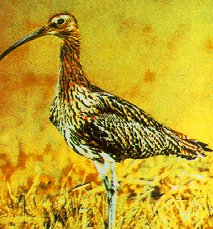 Synonyms: None.
Synonyms: None.Numenius arquata (Linnaeus, 1758)
 Synonyms: None.
Synonyms: None.
Common names: Engl: Curlew; Rom: Culic mare; Russ: Kronshnep bolshoy; Turk: Kervan cullugu; Ukr: Kronshnep velyky.
Order (Scientific): CHARADRIIFORMES.
Family (Scientific): SCOLOPACIDAE.
Taxonomic descriptions: Population size is no more than 8 pairs. During migration Curlews are usual in some places and produce concentrations of up to 70 specimens.
 IUCN Status:
IUCN Status:
World level:
Black Sea Regional level: EN
Subregion level: EN
Distribution:
Habitats type, Critical habitats, Limiting factors: Lowland estuaries and brackish lake coast, large sea-side sandy beaches are the main breeding habitats. Its nest has been found on fallow land. During migrations it is concentrated in coastal and shallow areas.
Biology: Breeding, migratory, summer vagrant and wintering species. Arrives at the beginning of March. Fall migration takes place from the third ten days of March to mid April. Small groups and single birds occur in May-June. Some pairs have an obvious breeding behavior. Breeding ecology has been insufficiently studied. A well incubated clutch was found on 25 April. Adult birds with a brood were recorded on 27 May. Autumn migration lingers from August to the early November, the most intensive movements are usually recorded on different dates in October. Single birds and small groups winter in the area. Its diet is animal (terrestrial insects and their larvae, worms, polychets, molluscs and frog larvae.
Population trends: In recent years the species has shows on ability to occupy new habitats such as the agrocoenosis.
Threats: Human disturbance, hunting, grazing in breeding sites.
Conservation measures taken: Curlews are protected in the Chernomorski Biosphere Reservoir and "Lebiazhi Ostrova" Reservoir.
Conservation measures proposed: Creation of a seasonal reservoirs network in the stop-over sites.
References:
Compiled by: V.Kinda.